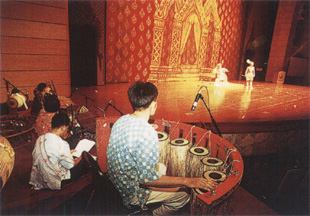|
|
|
The Arts
|
Music
Since ancient times, the Thai people
have known how to make musical instruments or to copy the patterns of others
and adapt them to their own u.scs. In fact,
there are several kinds of musical
instruments which the Thais apparently
devised before they came in contact
with the culture of India, which was
widespread in Southeast Asia before they
migrated there.

Classical Thai musical instruments
|
Later, when the Thai people were
establishing their kingdoms and had
come into contact with Indian culture,
particularly with Indian instruments
which the Mon and Khmcr cultures had
absorbed first, they assimilated this
musical culture into their own.
From this contact, the Thais created
several new kinds of musical instruments
such as the phin, pi chanui.
krachoppi, chakhe, and khim. which are
mentioned in the Trihhumikatha, one of
the first books written in Thai. and on a
stone inscription from the time of King
Ramkhamhaeng of the Sukholhai period.
Some songs of the Sukhothai period are
still sung at present, such as Phleng Thep Thong.
During the Ayutthaya period the
instrumental ensemble was composed of
four to eight musicians. Songs became
much longer and singing technique was
improved. Many Ayutthaya songs were
composed in a form of musical suite
called Phit-fif^ Rua, which was a series
of songs. Poets contributed lyrics in the
form of short stories, mostly from the
Ramakien, Many Ayutthaya songs are
still employed in Thai plays today.

HRH Princess Maha Chakri Sirindhorn, a skilled performer of Thai classical music
|
In the beginning of the Bangkok
era, after a long period of war, there was
a remarkable revival of Thai arts,
especially music and drama. The music of
the instrumental ensemble was enlarged
to twelve musicians and several masterpieces of Thai literature were produced
as theatrical performances accompanied
by music. Beautiful lyrics written by
contemporary poets were fitted into
melodies of the Ayutthaya period.
All Thai musicians in the past
received their training from teachers,
through constant playing and singing in
their presence. With nothing else 10 rely
upon except their own memory, it was
only through much hard work that they
gained their technical experience and
practical knowledge.
 |
HRH Princess Maha Chakri Sirindhorn performs the ``Pleng Thai Damnern Doi''
as an image of His Majesty the King trekking through the mountains dominates the background screen,
in Germany.
|
Later when Thailand began to have
contact with Western European nations
and the United States. Thais adopted
such Western instruments as the bass
drum, the violin, and the organ.
To save the national music from
extinction, modern Thai musicians are
trying to devise a system in which this
traditional music can he rendered into
Western notation and later edited.
According to a hook written by Sir
Hubert Perry, entitled Evolution of
the Art of Music. "The Thai scale system is extraordinary. It is not now
pcntatonic. though supposed to be
derived originally from the Javanese
system. The scale consists of seven notes
which should by right be exactly
equidistant from one another; thai is,
each step is a little less than a semitone
and three-quarlers. So that they have
neither a perfect fourth nor a true fifth
in their system, and both their thirds and
sixths are between major and minor; and
not a single note between a starling note
and its octave agrees with any of the
notes of the European scale. Their
sense of the right relations of the noles
of the scale are so highly developed that
their musicians can tell by ear directly a
note which is not true to their singular
theory. Moreover, with this scale, they
have developed a kind of musical art in
the highest degree complicated and extensive."

Likay, a popular form of theatre often seen at festivals
|
In all, there are about fifty lypes
of Thai musical instruments, including
many local versions of flulcs, stringed
instruments, and gongs used for all kinds
of occasions: festivals, folk theatre,
marriages, funerals, and social evenings
after harvesting.
Her Royal Highness Princess Maha
Chakri Sirindhorn is an accomplished
performer of several Thai classical
music instruments. She has become an
active leader of the movement to revive
interest in the rich cultural value of Thai
music among the younger generations,
Western Music.
During the last decade of the 20th
century, Thailand has witnessed the
flourish of Western music as never
before, and this development will surely
continue well into the 21st century.
Western classical music was
introduced to Thailand early in the 20th
century. Its development was nurtured
by Phra Chen Duriyang, a Westerner
who came to Thailand and served in the
Royal Thai government. He taught many
young Thai musicians in subjects like
theory, orchestration and applied
music and established Thailand's first
symphony orchestra. It has been said
that Thailand's orchestra under Phra
Chen's directorship was among the
best in Asia at that time. In 1934, this
orchestra was transferred to and became
the nucleus of the Fine Arts Department.
By the late 1920s, other small orchestras
had been established as part of the
branches of the Thai armed services.
One of the most distinguished orchestras
of this category is the Royal Thai Navy
Orchestra, still performing today.
Another group of musicians called
"Pro Musica" got together to perform and
discuss musical matters. They eventually
evolved in 1982 as the Bangkok Symphony
Orchestra, example, Mr. Piyabhand Sanitwongse
and Mr. Kamthom Sanitwongse. Generation after generation, the knowledge
is passed on and newer generations of
musicians have shown marked improvement in style and technique, knowledge
and skill, thus classical music in
Thailand improves and keeps moving forward.
| | |
|
|